
Back لر Arabic Lurlar AZ لورلار AZB Луры BE-X-OLD Лури Bulgarian লুর আদিবাসী Bengali/Bangla Luris Catalan Лурой CE لوڕ CKB Lúrové Czech
 Dasmâl-bâzi dance, Mamasani, Iran | |
| Total population | |
|---|---|
| 5,000,000 | |
| Regions with significant populations | |
| Iran | |
| Languages | |
| Luri and Persian | |
| Religion | |
| Mainly Shia Islam; minority Sunni Islam and Yarsanism[3] | |
| Related ethnic groups | |
| Other Iranian peoples | |
The Lurs, Lors or Luris (Persian: لر) are an Iranian people living in western and southern Iran.[4] The four Luri branches are the Bakhtiari, Mamasani, Kohgiluyeh and Lur proper, who are principally linked by the Luri language.[5]
Lorestan province is named after the Lurs, but some Lurs live in other provinces including Fars, Chaharmahal and Bakhtiari, Kohgiluyeh and Boyer-Ahmad, Khuzestan,[5] Hamadan,[6] Isfahan,[7] Tehran[8] southern Ilam province,[9] and Genaveh county in Bushehr province.[citation needed]
- ^ "Iran". The World Factbook. Retrieved 26 August 2013.
- ^ "Iran" (PDF). New America Foundation. June 12, 2009. Archived from the original (PDF) on 23 July 2013. Retrieved 26 August 2013.
- ^ Cite error: The named reference
iranicaonline.orgwas invoked but never defined (see the help page). - ^ "The Lurs of Iran | Cultural Survival". www.culturalsurvival.org. 2010-02-17. Retrieved 2024-11-20.
- ^ a b Minorsky, M. V. (2012). "Luristān". Encyclopedia of Islam. 2. doi:10.1163/1573-3912_islam_COM_0588.
- ^ Amanolahi, Sekander (2002). "Reza Shah and the Lurs: the Impact of the Modern State on Luristan". Iran and the Caucasus. 6: 193–218. doi:10.1163/157338402X00124.
- ^ Anonby, Erik John (2003). "Update on Luri: How many languages?". Journal of the Royal Asiatic Society. 13 (2): 171–172. doi:10.1017/S1356186303003067. S2CID 162293895.
- ^ Opie, James (1992). Tribal Rugs: Nomadic and Village Weavings from the Near East and Central Asia. 9781856690256: Pennsylvania State University. p. 104.
{{cite book}}: CS1 maint: location (link) - ^ Gheitasi, Mojtaba. "Language distribution: Ilam Province". Iran Atlas. Retrieved 18 November 2020.